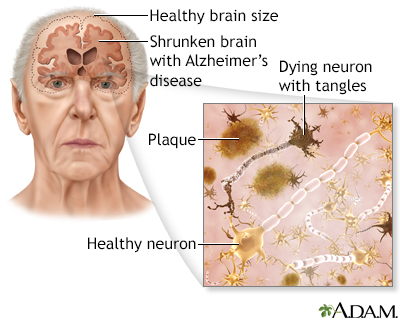Pregnancy SmartSiteTM
What to Expect at HomeIf your loved one has dementia, deciding when they can no longer drive may be difficult. They may react in different ways.
Signs That Driving may no Longer be SafePeople with signs of dementia should have regular driving tests. Even if they pass a driving test, they should be retested in 6 months. If your loved one does not want you getting involved in their driving, get help from their health care provider, lawyer, or other family members. Even before you see driving problems in someone with dementia, look for signs that the person may not be able to drive safely, such as:
Signs that driving may be getting more dangerous include:
Steps to TakeIt may help to set limits when driving problems start.
Caregivers should try to lessen the person's need to drive without making them feel isolated. Have someone deliver groceries, meals, or prescriptions to their home. Find a barber or hairdresser who will make home visits. Arrange for family and friends to visit and take them out for a few hours at a time. Plan other ways to get your loved one to places where they need to go. Family members or friends, buses, taxis, rideshares, and senior transportation services may be available. As danger to others or to your loved one increases, you may need to prevent them from being able to use the car. Ways to do this include:
ReferencesBudson AE, Solomon PR. Life adjustments for memory loss, Alzheimer's disease, and dementia. In: Budson AE, Solomon PR, eds. Memory Loss, Alzheimer's Disease, and Dementia. 3rd ed. Philadelphia, PA: Elsevier; 2022:chap 28. Carr DB, O'Neill D. Mobility and safety issues in drivers with dementia. Int Psychogeriatr. 2015;27(10):1613-1622. PMID: 26111454 pubmed.ncbi.nlm.nih.gov/26111454/. National Institute on Aging. Driving Safety and Alzheimer's Disease. www.nia.nih.gov/health/safety/driving-safety-and-alzheimers-disease. Updated April 3, 2023. Accessed June 11, 2024. | |
| |
Review Date: 5/20/2024 Reviewed By: Jacob Berman, MD, MPH, Clinical Assistant Professor of Medicine, Division of General Internal Medicine, University of Washington School of Medicine, Seattle, WA. Also reviewed by David C. Dugdale, MD, Medical Director, Brenda Conaway, Editorial Director, and the A.D.A.M. Editorial team. The information provided herein should not be used during any medical emergency or for the diagnosis or treatment of any medical condition. A licensed medical professional should be consulted for diagnosis and treatment of any and all medical conditions. Links to other sites are provided for information only -- they do not constitute endorsements of those other sites. No warranty of any kind, either expressed or implied, is made as to the accuracy, reliability, timeliness, or correctness of any translations made by a third-party service of the information provided herein into any other language. © 1997- A.D.A.M., a business unit of Ebix, Inc. Any duplication or distribution of the information contained herein is strictly prohibited. | |

 Alzheimer disease
Alzheimer disease
